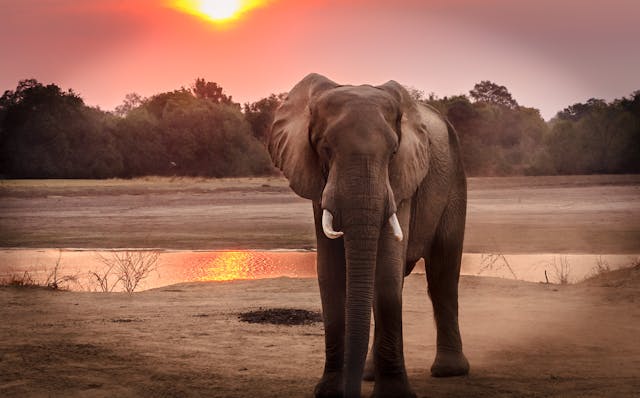
Do larger animals have a faster metabolism? No, bigger animals don’t have a faster metabolism. It tends to be the exact opposite.
Let’s look at what metabolism is. The metabolism of an organism refers to all of the chemical processes that go on within the cells to keep that organism alive. There are three main types of process. The first is converting the energy that is in the food we eat into the energy that all of our cells need to function. The second is converting the food we eat into the building blocks our cells use to make stuff. And the third is removing all of the waste material from our cells. If we didn’t have a metabolism, nothing in our body would work and we would die. The metabolism provides all of the energy needed for breathing, circulating blood, brain function, and every other process that goes on both consciously and unconsciously in our bodies. Every living thing has something called the basal metabolic rate, which is the amount of energy that organism uses at rest. We often hear that the average human male needs about 3,000 calories a day and the average female needs about 2,000. This is the basal metabolic rate. Those calories are the energy required to keep our body functioning at rest. This is our baseline.
Not all living organisms have the same kind of metabolism. Cold-blooded animals, such as crocodiles, have a much slower metabolic rate. Mammals are endothermic, which means we use energy to keep our bodies at an ideal temperature for them to function. To do this, we need to burn a lot of energy to make heat, or we have to try to lose a lot of heat energy to cool down. Both of these things affect our metabolic rate. Crocodiles, and all other lizards, are ectothermic, which means they do not sustain their own body temperature. They take on the temperature of their surroundings and often have to lie in the sun before they can do anything. Because of this, their metabolic rate is very low and they can go for months without eating.
Among endothermic animals, generally, the larger the animal, the slower its metabolism is and the longer it lives. These two things appear to be directly connected. So, why do larger animals have slower metabolisms? It is to do with the volume of the animal and what it is made up of. This topic can get a little confusing because larger animals need more energy because they are larger, but they need less energy per gram of flesh than smaller animals do.
The main reason why smaller animals have a higher metabolism is because of heat loss. The smaller an animal is, the more heat it loses and the more energy it has to convert from food just to keep its basic temperature. This is because of their volume to surface area. All organisms lose heat through their surface because it is the only part of them that the air contacts. As surface area gets larger, there is more heat loss, but larger animals also have a higher volume, which means they keep more heat in. A mouse has a very small body volume, but its surface area is very high. An elephant has a very large body volume, but a relatively smaller surface area in relation to its volume. Because of this, smaller animals have to eat a lot more and convert a lot more of their food into energy to make heat. To do this, smaller animals have more mitochondria in their cells to produce more energy. This also means that there is a limit to how small mammals can be because below a certain size, their surface area is too big compared to their volume and they cannot consume enough energy to keep warm.
Smaller animals also have more muscle mass in relation to their size than larger animals do. Their muscles take the same amount of energy to move as larger animals do, but because they are smaller and have a higher percentage of muscle, it requires a higher percentage of the energy they are consuming and converting. Smaller animals also make more rapid movements than larger ones, usually to escape from predators, and this uses more energy, which they have to replenish. To get all of the energy they need around their bodies, small animals have to eat a lot and they have very high resting heart rates to circulate the energy and the oxygen they use to burn it. Larger animals have larger hearts, so they can pump more blood with each beat.
The high metabolism is also a reason why small animals don’t live as long as large animals. Each time animals produce energy, they have to use oxygen for the chemical reaction. That basically oxidizes the cell and damages it, producing free radicals. The damage and free radicals build up to the point where they can’t be fixed and that becomes fatal. Smaller animals have a faster metabolism and burn more oxygen, creating more damage. This is known as the rate of living theory. It doesn’t always work, but it is true more often than it isn’t. And this is what I learned today.
Photo by Harvey Sapir: https://www.pexels.com/photo/wildlife-photography-of-elephant-during-golden-hour-1054655/
Sources
https://www.voronoiapp.com/nature/Small-Animals-Have-Higher-Resting-Heart-Rates–1246
https://pmc.ncbi.nlm.nih.gov/articles/PMC2064095
https://www.quora.com/Why-do-smaller-animals-have-higher-metabolism
https://en.wikipedia.org/wiki/Basal_metabolic_rate
https://en.wikipedia.org/wiki/Metabolism
https://my.clevelandclinic.org/health/body/21893-metabolism

Pingback: #583 Why are some animals cold-blooded?